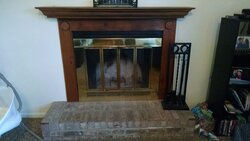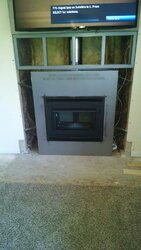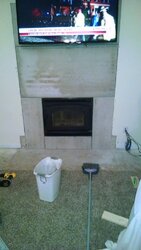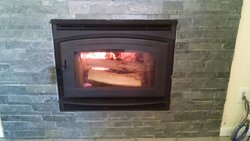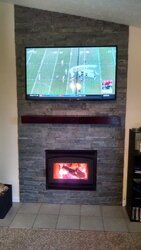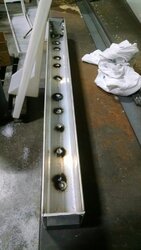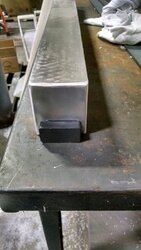New Pacific Energy FP30 Installation Progress Thread
- Thread starter saydinli
- Start date
-
Active since 1995, Hearth.com is THE place on the internet for free information and advice about wood stoves, pellet stoves and other energy saving equipment.
We strive to provide opinions, articles, discussions and history related to Hearth Products and in a more general sense, energy issues.
We promote the EFFICIENT, RESPONSIBLE, CLEAN and SAFE use of all fuels, whether renewable or fossil.
You are using an out of date browser. It may not display this or other websites correctly.
You should upgrade or use an alternative browser.
You should upgrade or use an alternative browser.
Saydinli..... Are you able to get a temp. Reading of the air exiting the basement heat dump?
I took a reading with my laser thermometer just above the centre of the door and it's 400. The grate at the remote vent is about 95-98. I've had it running for a couple of hours now relatively low because it's not too cold out now. Just hovering just above freezin.
Sent from my iPhone using Tapatalk
Moose720
New Member
Hello, I am new to this site and forum. I just had a Pacific Energy FP30 installed in my home about 3 weeks ago to replace the builders grade fireplace. I did all the tear out work, framing for the new fireplace, ran electric and other entertainment cables and wires behind the wall, as well as all the finish work on the inside. The stove shop that I bought the stove from installed the fireplace and flue as well as the SS chase cover. The unit heats my 1650sq. ft. two story home very well. The past few days here in Southwest Ohio, the temps have been getting into the mid teens at night and I can keep my house at 70 degrees in the upstairs bedrooms and about 74 degrees on the main floor where the fireplace is installed. I run the central air fan and ceiling fan when burning the fireplace to help move the warm air throughout the rest of the house.
Overall I am very satisfied with the performance of the unit although I do have two issues with it. First being that I get a rattle/vibration coming from the top of the unit when the blower fan is running. I contacted the stove shop that installed the unit and suggested I take out the bottom plate to access the blower fan area and make sure everything it tight. I have not done this yet due to time constraints and it being cold out. I am not sold as this would solve the issue because the noise is coming from the top of the unit. My other complaint is the cold draft that comes from the bottom vent when the fireplace is not in use. There is no way to close this off when the stove is not in use. I have an outside air duct running to the unit but there is no way to shut this vent. The area behind this vent is open to the bottom of the chase. Yes, the chase is insulated but cold air from that area comes into the house from that unheated area.
I am in the process of building an aluminum vent cover for this area. I am going to glue a magnet on each end of the cover and then place adhesive backed felt to the side the meets the fireplace surface to prevent scratches and help seal it off. Not sure how this will work out though. If anyone else has solutions to these two problems, please let me know. If I find solutions to them, I will for sure let everyone know.
Overall I am very satisfied with the performance of the unit although I do have two issues with it. First being that I get a rattle/vibration coming from the top of the unit when the blower fan is running. I contacted the stove shop that installed the unit and suggested I take out the bottom plate to access the blower fan area and make sure everything it tight. I have not done this yet due to time constraints and it being cold out. I am not sold as this would solve the issue because the noise is coming from the top of the unit. My other complaint is the cold draft that comes from the bottom vent when the fireplace is not in use. There is no way to close this off when the stove is not in use. I have an outside air duct running to the unit but there is no way to shut this vent. The area behind this vent is open to the bottom of the chase. Yes, the chase is insulated but cold air from that area comes into the house from that unheated area.
I am in the process of building an aluminum vent cover for this area. I am going to glue a magnet on each end of the cover and then place adhesive backed felt to the side the meets the fireplace surface to prevent scratches and help seal it off. Not sure how this will work out though. If anyone else has solutions to these two problems, please let me know. If I find solutions to them, I will for sure let everyone know.
Attachments
Last edited by a moderator:
Hello, I am new to this site and forum. I just had a Pacific Energy FP30 installed in my home about 3 weeks ago to replace the builders grade fireplace. I did all the tear out work, framing for the new fireplace, ran electric and other entertainment cables and wires behind the wall, as well as all the finish work on the inside. The stove shop that I bought the stove from installed the fireplace and flue as well as the SS chase cover. The unit heats my 1650sq. ft. two story home very well. The past few days here in Southwest Ohio, the temps have been getting into the mid teens at night and I can keep my house at 70 degrees in the upstairs bedrooms and about 74 degrees on the main floor where the fireplace is installed. I run the central air fan and ceiling fan when burning the fireplace to help move the warm air throughout the rest of the house. Overall I am very satisfied with the performance of the unit although I do have two issues with it. First being that I get a rattle/vibration coming from the top of the unit when the blower fan is running. I contacted the stove shop that installed the unit and suggested I take out the bottom plate to access the blower fan area and make sure everything it tight. I have not done this yet due to time constraints and it being cold out. I am not sold as this would solve the issue because the noise is coming from the top of the unit. My other complaint is the cold draft that comes from the bottom vent when the fireplace is not in use. There is no way to close this off when the stove is not in use. I have an outside air duct running to the unit but there is no way to shut this vent. The area behind this vent is open to the bottom of the chase. Yes, the chase is insulated but cold air from that area comes into the house from that unheated area. I am in the process of building an aluminum vent cover for this area. I am going to glue a magnet on each end of the cover and then place adhesive backed felt to the side the meets the fireplace surface to prevent scratches and help seal it off. Not sure how this will work out though. If anyone else has solutions to these two problems, please let me know. If I find solutions to them, I will for sure let everyone know.
I'm sure others with more experience (as I am only considering to purchase this unit) will have hands on knowledge, but ....maybe contacting pe directly will give you more insight as to what could be done with OAK (air kit). It sounds like you have a legit plan, just wondering if it would less complicated to have a cover for the outside vent? I know this require trekking outside to put in place or remove but would it stop the air from coming in the unit entirely? I wondering if you will have more of chance of condensation/ice up if you allow the air to come to the bottom of the unit? I did have hands on experience with a opel non cat stove and its OAK seemed to do the same thing as you are experiencing. That homeowner was not to concerned as he planned on firing the stove all the time when the cool temps were consistant. This was all happening while the home was under construction, so I understood his approach. What was concerning me was the actual formation of frost on the unit itself, which would start dripping once the stove was fired. I'm also quite interested in what others have to say about these issues.
I have noticed a bit of cool air around the air control coming from the OAK when the fp30 has cooled off (especially now that its getting realy cold here). But I've been burning 24/7 since installed at the beginning of Nov I haven't really noticed it being an issue a big issue.
One thing I did have to do last week ( at the advise of my dealer) was tape off about 80% of the outside vent to limit the amount of fresh air it was allowing into the firebox. Our chimney is about 26 ft tall with about 80% of it inside so we are getting a great draft, especially as it gets colder.
This seems to have helped in controlling the fire better. Before I blocked the OAK, the fire would easily get pretty crazy, even with the air control all the way down.
One thing I did have to do last week ( at the advise of my dealer) was tape off about 80% of the outside vent to limit the amount of fresh air it was allowing into the firebox. Our chimney is about 26 ft tall with about 80% of it inside so we are getting a great draft, especially as it gets colder.
This seems to have helped in controlling the fire better. Before I blocked the OAK, the fire would easily get pretty crazy, even with the air control all the way down.
Hello, I am new to this site and forum. I just had a Pacific Energy FP30 installed in my home about 3 weeks ago to replace the builders grade fireplace. I did all the tear out work, framing for the new fireplace, ran electric and other entertainment cables and wires behind the wall, as well as all the finish work on the inside. The stove shop that I bought the stove from installed the fireplace and flue as well as the SS chase cover. The unit heats my 1650sq. ft. two story home very well. The past few days here in Southwest Ohio, the temps have been getting into the mid teens at night and I can keep my house at 70 degrees in the upstairs bedrooms and about 74 degrees on the main floor where the fireplace is installed. I run the central air fan and ceiling fan when burning the fireplace to help move the warm air throughout the rest of the house. Overall I am very satisfied with the performance of the unit although I do have two issues with it. First being that I get a rattle/vibration coming from the top of the unit when the blower fan is running. I contacted the stove shop that installed the unit and suggested I take out the bottom plate to access the blower fan area and make sure everything it tight. I have not done this yet due to time constraints and it being cold out. I am not sold as this would solve the issue because the noise is coming from the top of the unit. My other complaint is the cold draft that comes from the bottom vent when the fireplace is not in use. There is no way to close this off when the stove is not in use. I have an outside air duct running to the unit but there is no way to shut this vent. The area behind this vent is open to the bottom of the chase. Yes, the chase is insulated but cold air from that area comes into the house from that unheated area. I am in the process of building an aluminum vent cover for this area. I am going to glue a magnet on each end of the cover and then place adhesive backed felt to the side the meets the fireplace surface to prevent scratches and help seal it off. Not sure how this will work out though. If anyone else has solutions to these two problems, please let me know. If I find solutions to them, I will for sure let everyone know.
Your install and finish work looks great!! Let me know if having the TV above the mantle is an issue woth regards to heat.
We are planning to do the same once the stone work is finished on ours (which won't be happening till Feb now due to our stone guy getting a hernia last week).
I noticed that when the fp 30 is cruising without the blower on, the top of the steel studs gets pretty damn hot and I'm concerned on what effect that might have on the TV. The mantle we're installing is about 8'"x 8" so it will deflect some heat but not sure if it''l be enough.
Moose720
New Member
I just finished up welding the vent cover and gluing the magnets to it. Result.....Failure....the magnets are not strong enough to hold the cover in place even without the felt. The material is 3/16" thick so I will try to make one from 1/8" to reduce the weight by 33%. It currently weights 4.66lbs and using 1/8" material, it will weigh about 3.12lbs, so the magnets should hold this version.
Attachments
Moose720
New Member
The mantle does deflect a lot of heat and with the blower on, the bottom of the TV is barely warm to the touch with a fire that has been burning for hours. I made the mantle, and it is 8" x 4". In order to mount the mantle, I had to use 1/4" toggle bolts thru the steel studs.
Weaselfest
Burning Hunk
Have you considered using sheet goods magnetic vinyl for your vent blockers? You can cut it to fit, comes in a wide assortment of colors and couldn't be easier to remove and re-attach.
http://www.magnetking.com/?gclid=CInOufn8_dACFQWnaQodmh8PTA#regularmagnet
http://www.magnetking.com/?gclid=CInOufn8_dACFQWnaQodmh8PTA#regularmagnet
Moose720
New Member
Saydinli, on your remote air duct, where are you going to put the air inlet. Why is an air inlet needed? Isn't the air/heat just pulled from the top of the unit to the remote outlet? I can see this remote inlet vent being another way for cooler air to draft into the house when the unit is not being used. Also, the manual says to put the remote blower on a different switch than the blower on the unit, would it be best to put these two switches in series so that when the blower of the unit turns on, the remote blower turns on as well? I believe I can run a remote duct directly into the main return within my central system and then run that fan to really move the heat throughout the house. Thoughts/Suggestions?
Saydinli, on your remote air duct, where are you going to put the air inlet. Why is an air inlet needed? Isn't the air/heat just pulled from the top of the unit to the remote outlet? I can see this remote inlet vent being another way for cooler air to draft into the house when the unit is not being used. Also, the manual says to put the remote blower on a different switch than the blower on the unit, would it be best to put these two switches in series so that when the blower of the unit turns on, the remote blower turns on as well? I believe I can run a remote duct directly into the main return within my central system and then run that fan to really move the heat throughout the house. Thoughts/Suggestions?
I'm going to be putting the air inlet on the right side of the chase close to floor level as suggested in the manual. The air is indeed being pulled from the top of the unit, but I suspect the vent is needed because the air is being drawn from the cavity between the the firebox and the steel casing around it. With a sealed chase, there may not be enough air for the remote duct fan to draw from if the chase is completely sealed off and then it may try to grab combustion air from any cracks or crevices in the unit that it can.
As for the fan switches, I wired them up separately as advised. I also put both on a rheostat(the remote vent kit comes with a rheostat). I guess you could wire them up in series, but I like having them separate for better individual control of both.
I was thinking about running the remote duct into my HVAC's ducting, however the distance from the unit to the main trunk was beyond the 20ft limit stated in the manual. But if you are within 20ft to your main return trunk you could do pretty good with moving the warm air around the house that way.
I have a low speed circulating fan running on my furnace that's moving the warm air from all the return ducts on the main and second floor. This does a nice job of balancing the temps around the house even in the far opposite corners.
Last edited:
Here is what I was told for the canadian building code rules.....I believe as of 2008 it is now illegal to have the heat dump tied directly into your hvac system. There was a case of a fire when a duct was tied into the return air side of the system. A hot spark or ash was drawn in and subsequently started a fire at the filter. A direct tie to the return air does add a serious risk for the chance of that happening. I am also under the impression that tying it into hot air side directly is not allowed here in ontario, due to the same accident. I was also told to pay attention to the word "directly" when setting up a good system with the remote fan kit.I'm going to be putting the air inlet on the right side of the chase close to floor level as suggested in the manual. The air is indeed being pulled from the top of the unit, but I suspect the vent is needed because the air is being drawn from the cavity between the the firebox and the steel casing around it. With a sealed chase, there may not be enough air for the remote duct fan to draw from if the chase is completely sealed off and then it may try to grab combustion air from any cracks or crevices in the unit that it can.
As for the fan switches, I wired them up separately as advised. I also put both on a rheostat(the remote vent kit comes with a rheostat). I guess you could wire them up in series, but I like having them separate for better individual control of both.
I was thinking about running the remote duct into my HVAC's ducting, however the distance from the unit to the main trunk was beyond the 20ft limit stated in the manual. But if you are within 20ft to your main return trunk you could do pretty good with moving the warm air around the house that way.
I have a low speed circulating fan running on my furnace that's moving the warm air from all the return ducts on the main and second floor. This does a nice job of balancing the temps around the house even in the far opposite corners.
Mechanical code in the US says there needs to be at least a 10ft separation between the stove and return air register.
A hot spark or ash was drawn in and subsequently started a fire at the filter. A direct tie to the return air does add a serious risk for the chance of that happening
I can't see how sparks or ash can get into the remote vent ducting as the firebox is sealed off from the air space cavity where the remote vent is pulling the heated air from.
Don't shoot the messenger.....humans are capable of amazing feats of stupidity. I have no clue what sort of setup had this fire.....im guessing it was nothing near a fp30. With your air supply on the right side, is there a slim chance it could suck ash in that is sitting on the ash lip of stove? I believe it's far fetched chance, but is it something to be mindful of if a person forgot to shut the fan off while reloading?I can't see how sparks or ash can get into the remote vent ducting as the firebox is sealed off from the air space cavity where the remote vent is pulling the heated air from.
Don't shoot the messenger.....humans are capable of amazing feats of stupidity. I have no clue what sort of setup had this fire.....im guessing it was nothing near a fp30. With your air supply on the right side, is there a slim chance it could suck ash in that is sitting on the ash lip of stove? I believe it's far fetched chance, but is it something to be mindful of if a person forgot to shut the fan off while reloading?
Anything is possible.
Do you have a update on your thoughts of this unit?
We are loving the FP30. It heats up our 2800 sq ft house better than we thought it would and the fire is just memorizing to watch, especially when the secondaries are going strong. I have to admit, I watch the fire almost as much as the TV LOL.
The only update I really have was that I taped off about 80% the OAK from the outside ( as recommended by my dealer) due to the crazy amount of fresh air the FP30 can draw with such a good drafting chimney that I have. Now my fires are much easier to control. Before I did this, it was pretty easy to get a full load into over firing territory.
I have also figured out that this beast likes big splits or full rounds best for long burn times. Got a good 9 hour burn last night using a couple of large splits (8") and a 6" round and 2 mediums splits. with ample coals left to heat another hour or so when I got up.
It looks like when I start accumulating next years wood this spring, I won't have to do as much splitting as most of the stuff I got this year is perfect for the FP30 (16" lengths x 6-8" avg width with alot of bigger splits up to 9-10"). The guy I got it from lives across the street from me and when he dropped the loads off I thought many were going to be too big (I didn' t have the actual unit yet) and I ended up splitting alot. Now I realize that I probably didn't have to split them as the FP30 likes the bug stuff.
Oh ya, our stone guy ended up getting a hernia and needed surgery so the finishing work won't start until around the beginning of Feb. Oh well at least we've been able to use it as is. It has saved us a couple of oil tank fills which is nice since the furnace hasn't run since the FP30 was installed.

Hogwildz
Minister of Fire
PE's love large splits. 3 or 4 larges on the bottom, filled in with mediums up top, and you'll find you get much longer than 8 hrs. These stoves love full loads, as they burn mostly from the top down. In time you will find yourself getting much longer burn times, depending on the wood species you're burning, and of course outdoor temps.We are loving the FP30. It heats up our 2800 sq ft house better than we thought it would and the fire is just memorizing to watch, especially when the secondaries are going strong. I have to admit, I watch the fire almost as much as the TV LOL.
The only update I really have was that I taped off about 80% the OAK from the outside ( as recommended by my dealer) due to the crazy amount of fresh air the FP30 can draw with such a good drafting chimney that I have. Now my fires are much easier to control. Before I did this, it was pretty easy to get a full load into over firing territory.
I have also figured out that this beast likes big splits or full rounds best for long burn times. Got a good 9 hour burn last night using a couple of large splits (8") and a 6" round and 2 mediums splits. with ample coals left to heat another hour or so when I got up.
It looks like when I start accumulating next years wood this spring, I won't have to do as much splitting as most of the stuff I got this year is perfect for the FP30 (16" lengths x 6-8" avg width with alot of bigger splits up to 9-10"). The guy I got it from lives across the street from me and when he dropped the loads off I thought many were going to be too big (I didn' t have the actual unit yet) and I ended up splitting alot. Now I realize that I probably didn't have to split them as the FP30 likes the bug stuff.
Oh ya, our stone guy ended up getting a hernia and needed surgery so the finishing work won't start until around the beginning of Feb. Oh well at least we've been able to use it as is. It has saved us a couple of oil tank fills which is nice since the furnace hasn't run since the FP30 was installed.
Ya I'm finding that the longer I'm using this fireplace the more I'm learning what it takes to get longer burn times.
I really love the versatility of the large firebox. NS or EW, it does not matter how I load the wood, it burns good.
Sent from my iPhone using Tapatalk
I really love the versatility of the large firebox. NS or EW, it does not matter how I load the wood, it burns good.
Sent from my iPhone using Tapatalk
Hogwildz
Minister of Fire
I found they tend to burn better, and more complete N-S configuration. Large splits and packed fairly tight will get you the longest burn times. The large split must be dry though. Another reason to be 3+ years ahead. You know the wood is dry by then, there is no wondering. I never liked the way mine burned E-W the times I tried it. Seems to leave unburnt splits &/or coals at the back. These really excel with north to south loads. Don't be afraid to load it up to the baffle. The ports in the baffle will blow right into the wood and burn it up real nice.
Mike M.
Feeling the Heat
Mike M.
Feeling the Heat
What's the reccomended length of wood, im going to cut some this week. I believe the specs say 20" but is it easier at say 16"? Or anywhere between those numbers 16"-20"?
Go with 16in wood, that will give you some flexibility. Also gives you some room for error if your not perfect about cutting exactly 16in.
Similar threads
- Replies
- 6
- Views
- 2K
- Replies
- 28
- Views
- 4K
- Replies
- 6
- Views
- 1K
- Replies
- 0
- Views
- 1K


